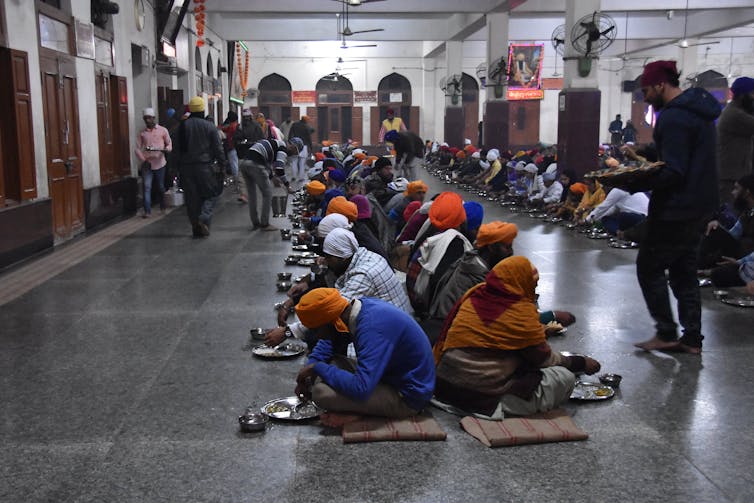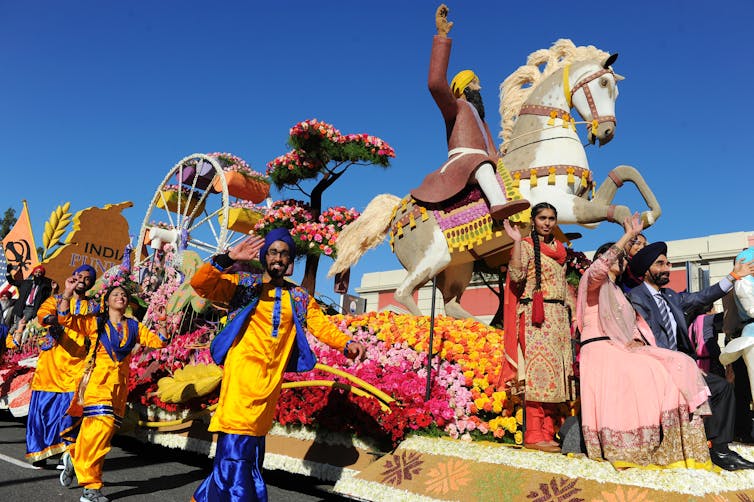Simran Jeet Singh, Union Theological Seminary
Ten years ago, a white supremacist opened fire on a Sikh congregation in Oak Creek, Wisconsin, killing six people and injuring several others before taking his own life. An eighth person, Baba Punjab Singh, was left partially paralyzed and died from his wounds a few years later.
At the time, it was among the deadliest mass shootings in a place of worship since the 16th Street Baptist Church bombing by the Ku Klux Klan in 1963. It was also the most lethal assault on Sikh Americans since they began migrating to the U.S. more than a century ago.
I recall journalists covering the massacre not knowing much about the Sikh community. One anchor referred to the gurdwara as a mosque and referred to the murdered as Muslims. Another reporter described the gurdwara as a Hindu temple. A third described the Sikh religion as a sect of Islam, using the term “sheikhs” rather than “Sikhs.”
Scholars and government officials estimate the Sikh American population to number around 500,000. Cultural ignorance has often made them targets of bigotry.
As the author of “The Light We Give: How Sikh Wisdom Can Transform Your Life” and as a practicing Sikh myself, I have studied the prejudices and barriers that many Sikhs in America face. I also experienced racial slurs from a young age.
The bottom line is there is little understanding in the U.S. of who exactly the Sikhs are and what they believe. So here’s a primer.
Founder of Sikhism
To start at the beginning, the founder of the Sikh tradition, Guru Nanak, was born in 1469 in the Punjab region of South Asia, which is currently split between Pakistan and the northwestern area of India. A majority of the global Sikh population still resides in Punjab on the Indian side of the border.
From a young age, Guru Nanak was disillusioned by the social inequities and religious hypocrisies he observed around him. He believed that a single divine force created the entire world and resided within it. In his belief, God was not separate from the world and watching from a distance, but fully present in every aspect of creation.
He therefore asserted that all people are equally divine and deserve to be treated as such.
To promote this vision of divine oneness and social equality, Guru Nanak created institutions and religious practices. He established community centers and places of worship, wrote his own scriptural compositions and appointed successors, known as gurus, who would carry forward his vision.
The Sikh view thus rejects all social distinctions that produce inequities, including gender, race, religion and caste, the predominant structure for social hierarchy in South Asia.

shankar s., CC BY
Serving the world is a natural expression of Sikh prayer and worship. Sikhs call this prayerful service “seva,” and it is a core part of their practice.
The Sikh identity
In the Sikh tradition, a truly religious person is one who cultivates the spiritual self while also serving the communities around them – or a saint-soldier. The saint-soldier ideal applies to women and men alike.
In this spirit, Sikh women and men maintain five articles of faith, popularly known as the five Ks. Those are: kes (long, uncut hair), kara (steel bracelet), kanga (wooden comb), kirpan (small sword) and kachera (soldier-shorts). Sikh philosophy teaches that all Sikhs are responsible for standing up against injustice, and that doing so is an act of service and love.
Although little historical evidence exists to explain why these particular articles were chosen, the five Ks continue to provide the community with a collective identity, binding together individuals on the basis of a shared belief and practice. As I understand, Sikhs cherish these articles of faith as gifts from their gurus.
Turbans are an important part of the Sikh identity. Both women and men may wear turbans. Like the articles of faith, Sikhs regard their turban as a gift given by their beloved guru, and its meaning is deeply personal. In South Asian culture, wearing a turban typically indicated one’s social status – kings and rulers once wore turbans. The Sikh gurus adopted the turban, in part, to remind Sikhs that all humans are sovereign, royal and ultimately equal.
Sikhs in America
Today, there are approximately 30 million Sikhs worldwide, making Sikhism the world’s fifth-largest religion.
After British colonizers in India seized power in Punjab in 1849, where a majority of the Sikh community was based, Sikhs began migrating to various regions controlled by the British Empire, including Southeast Asia, East Africa and the United Kingdom itself. Based on what was available to them, Sikhs played various roles in these communities, including military service, agricultural work and railway construction.
The first Sikh community entered the United States via the West Coast during the 1890s. They began experiencing discrimination immediately upon their arrival. For instance, the first race riot in the U.S. targeting Sikhs took place in Bellingham, Washington, in 1907. Angry mobs of white men rounded up Sikh laborers, beat them up and forced them to leave town.
The discrimination continued over the years. For instance, after my father moved from Punjab to the United States, around the time of the Iran hostage crisis in 1979, racial slurs like “Ayatollah” and “raghead” were hurled at him. Fifty-two American diplomats and citizens had been taken captive in Iran, and tension between the two countries was high. Sikhs had nothing to do with it, but they faced a racist backlash as their appearance corresponded with how Americans viewed their new enemies in Iran. Our family faced a similar racist backlash when the U.S. engaged in the Gulf War during the early 1990s.
The racist attacks spiked again after 9/11, particularly because Americans did not know about the Sikh religion and conflated the unique Sikh appearance with popular stereotypes of what terrorists look like.
The rates of violence against Sikhs surged after the election of President Donald Trump. The Sikh Coalition estimated in 2018 that Americans Sikhs were being targeted in hate crimes about once a week.

AP Photo/Michael Owen Baker
As a practicing Sikh, I can affirm that Sikhs’ commitment to the tenets of their faith, including love, service and justice, keeps them resilient in the face of violence. For these reasons, many Sikh Americans, including those affected by the massacre in Wisconsin, I believe, will continue to proudly maintain their unique Sikh identity.
This is an updated version of an article first published on Aug. 9, 2018.
[3 media outlets, 1 religion newsletter. Get stories from The Conversation, AP and RNS.]
![]()
Simran Jeet Singh, Visiting Lecturer, Union Theological Seminary
This article is republished from The Conversation under a Creative Commons license. Read the original article.







